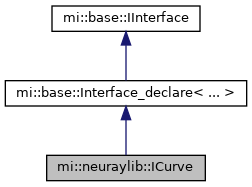A curve used by freeform surfaces. More...
#include <ifreeform_surface.h>

Public Member Functions | |
Methods related to curve types | |
| virtual Sint32 | set_type (Curve_type curve_type)=0 |
| Sets the curve type. More... | |
| virtual Curve_type | get_type () const =0 |
| Returns the curve type. More... | |
Methods related to curve segments | |
| virtual Uint32 | get_curve_segments_size () const =0 |
| Returns the number of curve segments. More... | |
| virtual ICurve_segment * | add_curve_segment ()=0 |
| Adds and returns a new curve segment. More... | |
| virtual const ICurve_segment * | access_curve_segment (Curve_segment_handle_struct s) const =0 |
| Returns a curve segment (const). More... | |
| virtual ICurve_segment * | edit_curve_segment (Curve_segment_handle_struct s)=0 |
| Returns a curve segment (mutable). More... | |
| virtual Sint32 | remove_curve_segment (Curve_segment_handle_struct s)=0 |
| Removes a curve segment. More... | |
 Public Member Functions inherited from mi::base::IInterface Public Member Functions inherited from mi::base::IInterface | |
| virtual Uint32 | retain () const =0 |
| Increments the reference count. More... | |
| virtual Uint32 | release () const =0 |
| Decrements the reference count. More... | |
| virtual const IInterface * | get_interface (const Uuid &interface_id) const =0 |
| Acquires a const interface from another. More... | |
| template<class T> | |
| const T * | get_interface () const |
| Acquires a const interface from another. More... | |
| virtual IInterface * | get_interface (const Uuid &interface_id)=0 |
| Acquires a mutable interface from another. More... | |
| template<class T> | |
| T * | get_interface () |
| Acquires a mutable interface from another. More... | |
| virtual Uuid | get_iid () const =0 |
| Returns the interface ID of the most derived interface. More... | |
Additional Inherited Members | |
 Public Types inherited from mi::base::Interface_declare< 0xa4e79414, ... > Public Types inherited from mi::base::Interface_declare< 0xa4e79414, ... > | |
| typedef Interface_declare< id1, ... > | Self |
| Own type. More... | |
| typedef Uuid_t< id1, ... > | IID |
| Declares the interface ID (IID) of this interface. More... | |
 Public Types inherited from mi::base::IInterface Public Types inherited from mi::base::IInterface | |
| typedef Uuid_t<0, 0, 0, 0, 0, 0, 0, 0, 0, 0, 0> | IID |
| Declares the interface ID (IID) of this interface. More... | |
 Static Public Member Functions inherited from mi::base::Interface_declare< 0xa4e79414, ... > Static Public Member Functions inherited from mi::base::Interface_declare< 0xa4e79414, ... > | |
| static bool | compare_iid (const Uuid &iid) |
Compares the interface ID iid against the interface ID of this interface and of its ancestors. More... | |
 Static Public Member Functions inherited from mi::base::IInterface Static Public Member Functions inherited from mi::base::IInterface | |
| static bool | compare_iid (const Uuid &iid) |
Compares the interface ID iid against the interface ID of this interface. More... | |
A curve used by freeform surfaces.
Surfaces allow the definition of parametric curves that cut away parts of the surface. Curves need to be closed and may not intersect themselves or other curves on the same surface. The curves are called parametric because they are defined in the surface's UV space - all curve control points have only two coordinates (U and V). The UV coordinates must be in the parameter space of the surface (which might be restricted by its range parameters).
There are two types of curves, trim curves and hole curves. A trim curve cuts away all parts of the surface outside the curve. A hole curve cuts away all parts inside the curve. Curves can be nested: a trim curve inside a hole curve "restores" the surface area inside the inner trim curve. Nested curves need to have alternating types and must be specified in the correct order from the outermost to the innermost. Non-nested curves can be specified in any order. Clockwise/counterclockwise ordering is not significant.
A curve consists of one or more curve segments. Segments are similar to surfaces, except that they are only 1-dimensional (and as the curve, are defined not in 3D space, but in the UV parameter space of the surface).
Curve segments are stored with consecutive indices, starting with the index 0. For type safety, indices of curve segments are represented using mi::neuraylib::Curve_segment_handle instead of plain integers.
|
pure virtual |
Returns a curve segment (const).
|
pure virtual |
Adds and returns a new curve segment.
|
pure virtual |
Returns a curve segment (mutable).
|
pure virtual |
Returns the number of curve segments.
|
pure virtual |
Returns the curve type.
|
pure virtual |
Removes a curve segment.
Note that the curve segment IDs of the following curve segments are decreased by 1.
|
pure virtual |
Sets the curve type.
| curve_type | The desired curve type. |